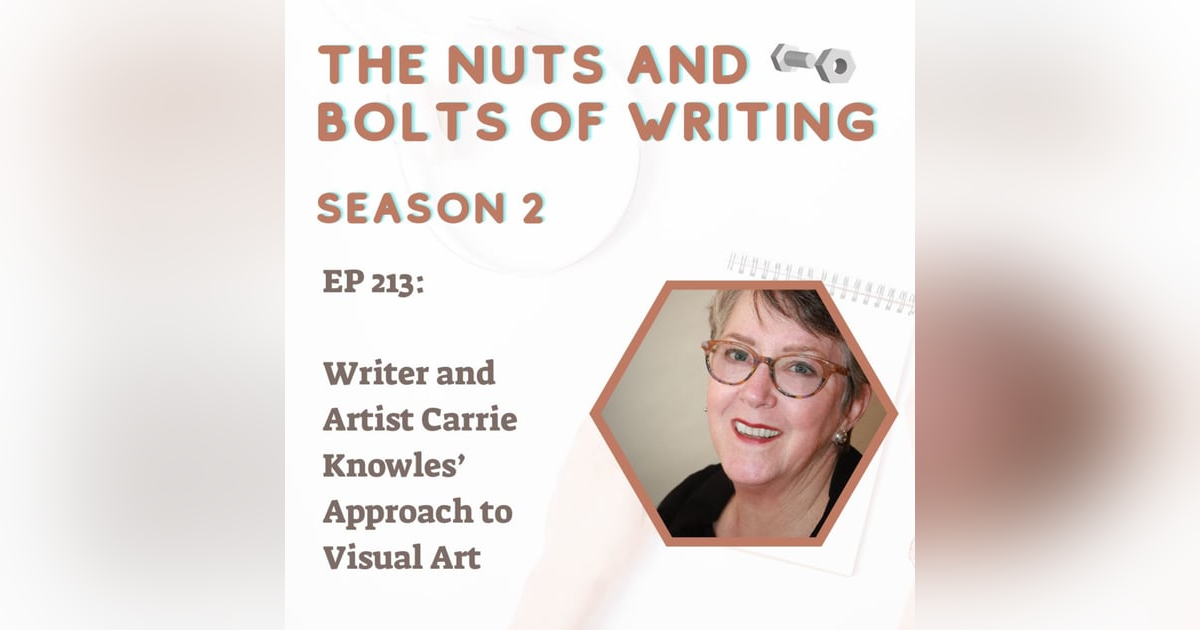
Sign up to get updates from us
By signing up, you agree to receive email from this podcast.

Hi, everyone. Today, we’re talking to artist and writer Carrie Knowles about her approach to visual art. This is part three of our interviews with Carrie — please check out episodes 211 and 212 for my previous discussions with her about writing fiction and non-fiction, respectively.
Carrie Knowles is a prolific award-winning author and arts advocate. Along with her nine books, she has published short stories, newspaper and magazine articles, and received numerous awards for her writing.
In addition to being a writer, she is also a visual artist. In 2017, she was invited to be one of seven international artists for a special exhibition in Brisbane, Australia. The seven of them were all artists who worked in more than one genre. The theme of the show was “The Inevitable Past”. They were tasked with the job of responding to the theme by bringing together their artwork with their other creative voice.
In thinking about what was inevitable about her own past, Carrie began writing about her father’s mother who died during his birth leaving many unanswered questions as to who she was and where she was going when she arrived at the Door of Hope (a home for unwed mothers in Macon, Georgia) badly beaten, unconscious, and very pregnant.
Here’s what the curator of the show wrote about Carrie’s work:
It has been asked 'is Carrie an author who aeates visual art, or an artist who writes?' For her, it is all part of the one thing. While her literary work has often dominated her creative endeavors, the multi-levelled cross-overs between these fields, though often subtle,are implicitly present.
Growing up in middle America with a high achieving father, who was also blind, her drive to do her own thing (be a writer and artist), while rejecting all perceived limitations, WAS almost inevitable. Initially inspired to paint, parental pressure to do something less 'self·indulgent' saw her commence tertiary study in Physical Therapies, before switching to an Engllsh major — Carrie the author was born. Journalism, writing education papers, and teaching (writing and art) followed before postgraduate studies in sociology and psychology.
Yet throughout, her creative expression in both literary and visual forms continued. Now the author of five intimately moving books (fiction and non-fiction, in which the constant passsage of time is a pivotal context), innumerable articles, short stories, poetry and social commentaries — with a growing number of awards — her equally emotive visual art has always been nascently entwined with her literary practice, and each is increasingly informed by and reflective of the other.
To read more about how writing about her own inevitable past developed into a novel, and how the artwork she presented in Brisbane became a 27 foot-long hand dyed and embroidered linen shroud, go to Carrie’s website: https://www.cjanework.com/the-inevitable-past
In the past two episodes, we talked to Carrie about her approach to writing fiction and non-fiction. In this episode, we’ll be talking about Carrie’s approach to visual arts.
What is your favorite medium to work with? (i.e., watercolour, colored pencil, etc.)
What are your favorite subjects in art?
Who are your favorite artists?
What are your main sources of inspiration?
In your view, what is the relationship of visual arts and writing?
You can purchase and see some of Carrie’s art through Marguerite Guitreau’s online store: https://www.chairish.com/shop/margueriteguitreau
Marguerite Guitreau’s Instagram: https://www.instagram.com/marguerite_guitreau/
--- Send in a voice message: https://podcasters.spotify.com/pod/show/fortunus-games/message